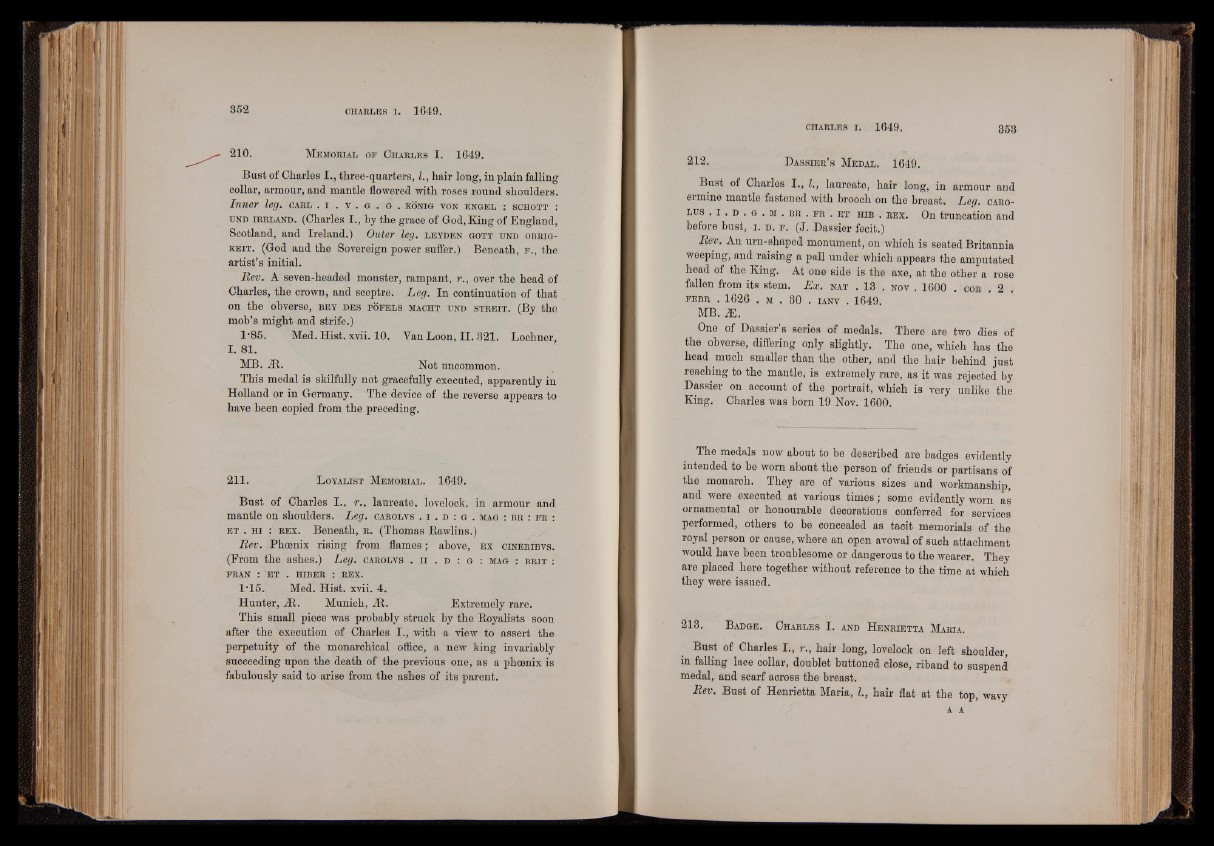
Bust of Charles I., three-quarters, L, hair long, in plain falling
collar, armour, and mantle flowered with roses round shoulders.
Inner leg, carl . i . v . g . g . k o n ig yon e n g e l : sc h o t t :
u n d ir r l a n d . (Charles I., by the grace of God, King of England,
Scotland, and Ireland.) Outer leg. l e y d e n g o t t u n d o b r ig -
k e i t . (God and the Sovereign power suffer.) Beneath, f ., the
artist’s initial.
Rev. A seven-headed monster, rampant, r., over the head of
Charles, the crown, and sceptre. Leg. In continuation of that
on the obverse, b e y d e s p o f e l s macht und s t r e it . (By the
mob’s might and strife.)
1‘85. Med. Hist. xvii. 10. Van Loon, II. 321. Lochner,
I. 81.
MB. 51. Not uncommon.
This medal is skilfully not gracefully executed, apparently in
Holland or in Germany. The device of the reverse appears to
have been copied from the preceding.
211. L o y a l is t M em o r ia l . 1649.
Bust of Charles I., r., laureate, loveloek, in armour and
mantle on shoulders. Leg. cabolvs . i . d : g . mag : b r : f r :
e t . h i : r e x . Beneath, r . (Thomas Rawlins.)
Rev. Phcenix rising from flames; above, e x c in e r ib v s .
(From the ashes.) Leg. carolvs . i i . d : g : mag : b r it :
FRAN : ET . HIBER : REX.
1-15. Med. Hist. xvii. 4.
Hunter, 5 t. Munich, 5 t. Extremely rare.
This small piece was probably struck by the Royalists soon
after the execution of Charles I., with a view to assert the
perpetuity of the monarchical office, a new king invariably
succeeding upon the death of the previous one, as a phoenix is
fabulously said to arise from the ashes of its parent.
Bust of Charles I., I., laureate, hair long, in armour and
ermine mantle fastened with brooch on the breast. Leg. caro-
l u s , i . d . g . m . b r . f r . e t h ib . r e x . On truncation and
before bust, i. d . f . (J. Dassier fecit.)
Rev. An urn-shaped monument, on which is seated Britannia
weeping, and raising a pall under which appears the amputated
head of the King. At one side is the axe, at the other a rose
fallen from its stem. Ex. nat . 13 . nov . 1600 . cor . 2
FEBR . 1626 . m . 30 . ianv . 1649.
MB. M.
One of Dassier’s series of medals. There are two dies of
the obverse, differing only slightly. The one, which has the
head much smaller than the other, and the hair behind just
reaching to the mantle, is extremely rare, as it was rejected by
Dassier on account of the portrait, which is very unlike the
King. Charles was born 19 Nov. 1600.
The medals now about to he described are badges evidently
intended to be worn about the person of friends or partisans of
the monarch. They are of various sizes and workmanship,
and were executed at various times j some evidently worn as
ornamental or honourable decorations conferred for services
performed, others to be concealed as tacit memorials of the
royal person or cause, where an open avowal of such attachment
would have been troublesome or dangerous to the wearer. They
are placed here together without reference to the time at which
they were issued.
213. B a d g e . C h a r l e s I. and H e n r ie t t a M a r ia .
Bust of Charles I., r., hair long, lovelock on left shoulder,
in falling lace collar, doublet buttoned close, riband to suspend
medal, and scarf across the breast.
Rev. Bust of Henrietta Maria, I , hair flat at the top, wavy
A A